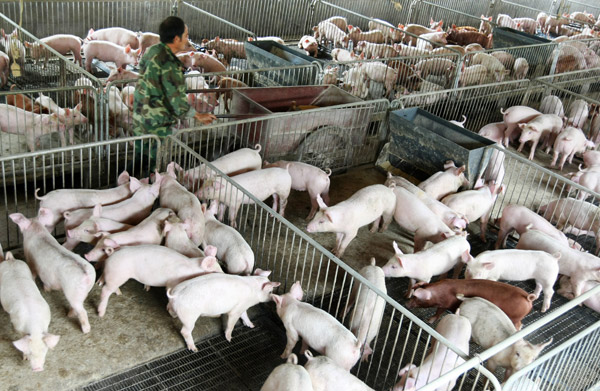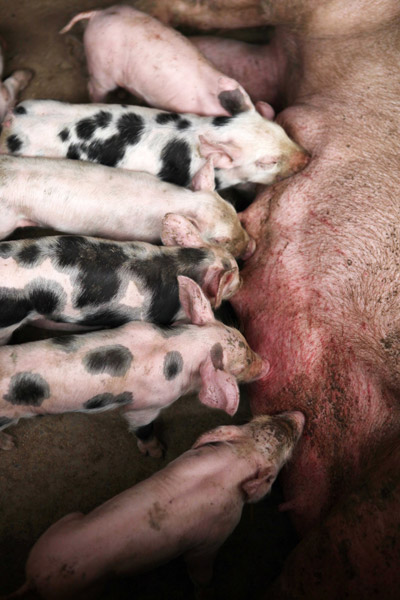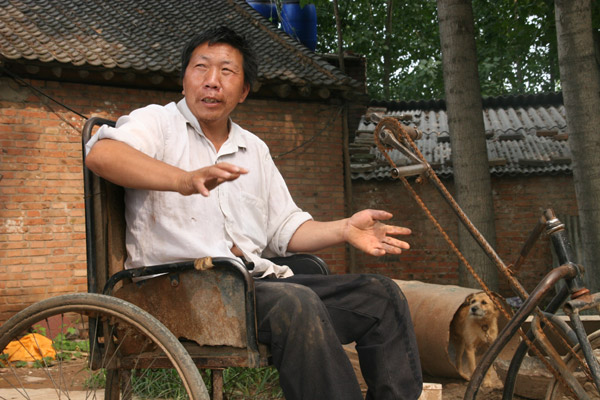Rising costs and diminishing returns bring new approach, Yang Wanli and Shi Baoyin report from Henan.
China, the world's leading pork producer, is changing the way it raises pigs.
 |
|
Even a family pig farm can bring a lot of hogs to market, like this one in Fengqiao village, Zhuji, Zhejiang province. But smaller operations are closing because of unstable prices and havoc caused by disease. [Photo/Agencies] |
At one end, small family farms are buckling under the weight of volatile prices, disease and rising costs.
At the other end, industrial-scale farms are becoming part of the landscape. But between these two options is a new cooperative venture that combines the personal attention of the family farm with the economic advantages of a corporation.
Yang Zhongxi, 44, of Qinyang, Henan province, has had to change his farming methods recently.
He used to raise more than 100 pigs at a time, making him the most prolific pig farmer in his village. In May 2010, he spent 100,000 yuan ($15,700) building a new barn capable of holding 200 pigs, plus hundreds of ducks and chickens.
But higher costs and lower returns took their toll and he quit the pig business earlier this year. Only the birds inhabit the big new barn.
"The cost of raising hogs has soared this year," he said. "Four or five years ago, a baby pig cost 300 yuan. It is double that now."
It has always been a high-risk business, but local farmers welcomed it, Yang said. "Generally, we could still make money." Ten years ago, 15 or 16 small-scale breeders lived in his village. Now only two are left.
Yang said the price of feed, usually field corn, increased in his village by 0.4 yuan a kilogram early this year. A pig usually requires 300 kg of feed during its five-month growth period, so feeding each pig suddenly cost an extra 120 yuan. Five years ago, Yang said, the cost of raising a hog totaled about 1,000 yuan; now it's about 1,500 yuan. The selling price, 2,500 yuan, hasn't changed.
"Doing city jobs only paid 10 to 20 yuan a day years ago, and people would rather raise hogs," Yang said. "But now, people make 100 yuan a day by doing city jobs. Who would choose breeding pigs?"
Too much work
Ten miles away, Li Qinying barely maintains her hog barn. Twenty pigs live in what used to hold nearly 150, and they are the last she will raise.
"It's too tiring," said Li, 54. "People say the more plowing and weeding, the better the crop. It doesn't make sense in this industry.
"Epidemic prevention is a big problem," Li said. Early last year, dozens of young pigs got sick and died overnight. The cause remains a mystery. "It is hard to accept because I took them as my babies and sometimes didn't step out of the pig house for months."
The wildly fluctuating price also is killing Li's passion for raising pigs.
A couple of weeks ago, she heard that the market price had hit 20.4 yuan a kg, and she planned to sell some pigs. But the price dropped to 19.2 yuan the next day. "The final deal was just 18.2 yuan. That hurt me badly."
More reason
 |
|
Piglets are fed in the traditional way until it's time to grow them into market size. [Photo/ China Daily] |
Li is among many family breeders across the country who have chosen to leave the business since an outbreak of H1N1 flu in 2008. Steadily rising costs have deterred them, too, and one result was a near 60 percent jump in pork prices early this year.
Jin Yingfu, director of Qinyang husbandry bureau, said Henan has produced 50 million hogs on average every year, accounting for nearly 10 percent of the country's total. Qinyang's average production is more than 200,000, ranking it in the middle range.
The production has come from nearly 26,000 family breeders in Qinyang. Ninety percent of them have fewer than 1,000 pigs. Fewer than 25 have 1,000 to 4,000 pigs.
That is changing. "Many small-scale breeders withdrew from the market early this year in view of the rising breeding costs as well as the epidemics," Jin said.
From January through March, the market price for hogs in some cities in Henan held at 14 to 15 yuan a kilogram, according to the Henan Statistics Bureau. It climbed in the second quarter, and peaked near 19 yuan a kg.
However, Jin said the rising price didn't inspire farmers to buy many more piglets. "Farmers worried about another sharp drop in meat prices due to oversupply."
To drive down pork prices and avert fluctuations longer term, the central government invested heavily in the industry to feed its growing middle class, which is consuming more meat. The government decided in July to resume a 2.5 billion yuan (about $389 million) subsidy to spur pig breeding and prevent future supply shocks.
The subsidies are based on production. The minimum is 200,000 yuan for producers of 500 to 900 hogs, and the maximum is 800,000 yuan for producers with more than 3,000 hogs. Small family pig farmers, then, are left out.
Fewer family raisers
China, the world's largest pork consumer, also is the largest producer, with about 50 million tons of meat each year to feed its 1.3 billion people and 55 percent of global production. However, production is increasingly concentrated.
Through the mid-1990s, more than 90 percent of the country's pig breeders were those small family farms, each producing 40 to 50 hogs a year. Then farmers began to reduce their risk by cooperating with big companies.
In neighboring Hunan province, the number of breeders with fewer than 50 pigs dropped 30 percent in recent years, Zhou Xiaorong, president of the Hunan Meat Association, told Xinhua News Agency in July. In East China's Shandong province, an estimated 90 percent of breeders raise at least 50 pigs, according to the Shandong Hog Raising and Selling Association.
The Ministry of Agriculture said that in 2007, half of China's hogs were produced by 2.2 million breeders raising more than 50 hogs at a time. The next year, those breeders provided 62 percent of the hogs.
Better option
About half an hour's drive from downtown Zhengzhou, 35-year-old Zhou Hui is taking care of 40 pregnant hogs. She and her husband live in a small white house that connects two hog barns. The couple are not family breeders, but work for a large-scale company, Chuying.
The company, based in Henan, sold about 660,000 hogs last year. It developed a "staging" breed mode that has attracted thousands of participating farmers.
Chuying divided the traditional raising process into four stages - pregnancy, delivery, care of baby pigs, and raising them to market size. The farmers are guided by trained technicians and are involved in just a single process, which can prevent the spread of disease.
To get into Chuying's No 1 Breeding Base, a car passes twice through sanitation showers about 300 meters away. Technician Liu Qingfeng said visitors cannot enter unless two days have elapsed since they visited another farm, and they must wear protective clothing.
"Pigs are easily susceptible to illness," he said. "For safety's sake, even the breeders do not go out of the base before they finish a single breeding process."
Liu said family pig farmers lose 17 to 20 percent of their pigs to illness, but the rate in Chuying's system is 5 to 6 percent.
The No 1 Breeding Base covers 133 hectares and has more than 400 barns, each holding about 40 pigs. The young ones arrive weighing 25 to 30 kg and will reach 100 to 160 kg over three months.
Chuying has 80 other breeding bases in the province, each with a single stage. The workers, who are independent contractors, are paid according to how much work is required, not the specific job or stage they are involved in. The stages vary in length, from about 40 days to 90.
Breeders take 10 to 15 days off after finishing a stage, and the work provides steady income without the fears associated with unstable meat prices.
Zhou and her husband earned 120,000 yuan last year, taking in twice the number of hogs than most people. "This job is easy and gives me more freedom," Zhou said. "At least we don't need to punch a time card, like white-collar workers."
Zhou and her husband started to work with Chuying in 2003. Last year they bought a two-floor apartment in Xinzheng, a 10-minute drive from the farm.
"Our life doesn't sound like a traditional hog breeding family, right? Group working gives us confidence and safety that we could hardly imagine before," Zhou said.
Bigger map
 |
|
Yang Zhongxi explains why he quit the business in Henan province this year.[Photo/Agencies] |
Of the 609 million hogs China raised in 2008, only 1 percent came from hog producers raising more than 50,000 pigs every year. US-based Smithfield Foods has about 900,000 sows producing 14 million market hogs annually, making it the world's largest producer of hogs.
China is on its way toward large scale. A growing number of companies have laid out plans to build massive industrial-scale pig farms. Chuying is investing 4 billion yuan to build a 400,000-hectare organic pig-breeding farm in Henan that would have an annual capacity of 1 million hogs.
Sichuan-based New Hope Group, China's top animal feed producer, plans to expand its own hog production by 3 million in the next three years to tap growing domestic demand.
Thailand's CP Group has started construction of a 500,000 hogs-a-year farm in Shandong province. The company is also building two farms to produce 1 million pigs a year, one each in Guangdong and Henan provinces.
Li Minghui, a research fellow with the Chinese Academy of Agricultural Sciences, said that more family pig farmers have signed up with larger scale companies. "Small breeders have very limited capability to withstand market risks," he said. "The structure change will benefit both raisers and consumers."
Increasing exports
The US Department of Agriculture recently published a report, "US pork exports to China are increasing". It cited China's strong economic growth, market demand for pork and declines in China's pork production.
US exports to the Chinese mainland reached 192,500 metric tons (valued at $169 million) in the eight months ending in February 2011. Exports to Hong Kong (most of which are re-exported to the mainland) added 63,600 tons ($92 million) to this total.
According to the US Meat Export Federation, US pork exports to the mainland jumped 1,492 percent in the first half of 2011.
"We cannot simply say that increasing imports will hurt Chinese raisers. It takes time for us large-scale companies to hold a bigger share of the market," said Wu Yide, Chuying's board secretary.
"Imported meat or foreign investment will not shake an industry that has existed in China for thousands of years."
Gao Mei and Chang Cheng contributed to this report.
